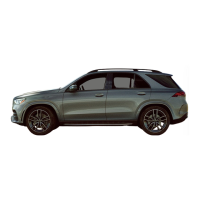
Do you have a question about the Mercedes-Benz GLE Coupe 2021 and is the answer not in the manual?
| Brand | Mercedes-Benz |
|---|---|
| Model | GLE Coupe 2021 |
| Category | Automobile |
| Language | English |
Overview of the vehicle's cockpit controls and layout, including steering wheel and displays.
Explains the meaning of various indicator and warning lamps in the driver display for quick recognition.
Details on adjusting door controls and seats for optimal comfort and safety, including electric adjustments.
Information on handling emergencies and breakdowns, including safety vests, warning triangles, and first-aid kits.
Instructions on accessing the digital manual via the multimedia system, driver display, and voice assistant.
Importance of using approved parts and consequences of using non-approved parts for safety and warranty.
Warnings and recommendations for safe operation, including modifications, electronic components, and driving too fast.
Information on data processing in the vehicle, personal data collection, and legal requirements for data disclosure.
Importance of using qualified workshops for special skills and safety-relevant work.
Details on seat belts, airbags, and child restraint systems for occupant protection in accidents.
Guidance on correct fastening and adjustment of seat belts for optimal protection and warnings about incorrect use.
Overview of airbag types, installation locations, potential protection, and risks associated with modifications.
Safety notes and recommendations for using child restraint systems correctly, including ISOFIX and seat belt methods.
Explanation of anticipatory occupant protection measures like seat belt tightening and closing side windows.
Overview of key functions, including removing/inserting the emergency key and replacing the battery.
Notes on the additional door lock (UK only) and unlocking/opening doors from the inside.
Information on opening the tailgate and notes on damage caused by obstacles or unintentional opening.
Instructions for opening, closing, and troubleshooting the sliding sunroof, including automatic functions and entrapment risks.
Information on the function of the immobiliser and the ATA (Anti-Theft Alarm) system for vehicle security.
Guidance on adjusting the driver's seat, head restraints, and steering wheel for optimal driving posture and airbag effectiveness.
Instructions for adjusting front seats mechanically and electrically, including lumbar support and head restraints.
Overview of stowage compartments and notes on loading the vehicle correctly to prevent injury.
Instructions for folding rear seat backrests forward mechanically and electrically for cargo access.
Notes on the load compartment cover and instructions for fitting/removing the partitioning net for securing cargo.
Information on using the 12 V socket and connecting devices, including power limits.
Notes on adjusting lights for driving abroad and manual adjustment procedures to avoid dazzling oncoming traffic.
How automatic driving lights function based on ignition status and ambient light conditions.
Details on Intelligent Light System features like Active headlamps, Cornering light, Motorway mode, and Enhanced fog light.
Functionality and system limits of Adaptive Highbeam Assist, including warnings for accident risk due to limited detection.
Functionality and system limits of Adaptive Highbeam Assist Plus, emphasizing driver responsibility.
Explains THERMATIC and THERMOTRONIC climate bars and button functions for controlling interior climate.
How to set air distribution for front and rear seats, including manual and automatic modes.
Details on synchronizing climate settings via control panel or multimedia system for consistent cabin temperature.
Instructions for activating and deactivating windscreen demisting for clear visibility.
Information on using the stationary heater/ventilation function, including requirements and safety warnings.
How to set departure times and repeat days for pre-entry climate control for a comfortable cabin upon arrival.
Instructions on how to switch on the power supply and ignition using the start/stop button, including warnings about unattended children.
Procedures for starting the vehicle with the start/stop button or key, including emergency operation modes.
Important notes for the first 1,500 km of driving to preserve the engine and components, including driving tips.
How the ECO start/stop function works, including automatic engine stop and restart conditions.
Functionality of the DYNAMIC SELECT button for changing drive programs (Comfort, Sport, Sport+, Individual) to suit driving conditions.
Information on the DIRECT SELECT lever, including engaging drive positions and manual gearshifting.
Important notes on refuelling the vehicle, including fuel types, safety precautions, and AdBlue® notes.
Instructions on how to park the vehicle safely, including using the parking brake, transmission positions, and avoiding rolling away.
Function of the electric parking brake, including automatic application, manual control, and emergency braking procedures.
Overview of driving systems that assist the driver, emphasizing driver responsibility and system limitations.
How ABS regulates brake pressure to prevent wheel lock during critical braking situations.
How BAS supports emergency braking by boosting brake pressure and shortening braking distance.
How ESP® monitors and improves driving stability and traction, including its deactivation conditions.
How DISTRONIC maintains set speed and distance, including warnings for acceleration/braking risks.
How the system monitors lane markings and provides steering intervention to keep the vehicle in lane.
Electronic parking assistance system using cameras and sensors for parking maneuvers, including warnings for distorted views.
Notes on trailer operation, including tongue weight, towing capacity, and coupling/uncoupling procedures.
Warnings and notes regarding the correct use, mounting, and load capacity of bicycle racks.
Notes on electrical fuses, including risks of overloaded lines, incorrect fuse usage, and damage from moisture.
Information about driver display malfunctions and general operating safety warnings.
How to operate the driver display, including scrolling menus and using Touch Control.
Overview of available menus like Navigation, Assistance, and Service for configuring display content.
Function of the head-up display and how to select different contexts and adjust settings.
Explains status displays for driving and safety systems, including indicator lamps and their meanings.
Notes on the MBUX multimedia system, including operating Touch Control, central display, and system functions.
Explanation of the home screen layout, status line, applications grid, and Control Center functions.
Available functions for making calls, managing contacts, and sending messages via voice commands.
Information on Mercedes me connect services, including Accident and Breakdown Management, emergency call system, and data protection.
Overview of navigation features, including digital map, route guidance with augmented reality, and entering destinations.
Overview of symbols and functions in the media menu, including playback controls and browsing capabilities.
Available functions and settings for the sound system, including equalizer, balance, fader, and sound profiles.
Information on service intervals and how to display service due dates, considering operating conditions.
Details on active bonnet operation and opening/closing the bonnet, including safety warnings.
Instructions on checking and topping up engine oil, including warnings about incorrect use and the importance of approved oils.
Procedures for checking and topping up coolant, including safety precautions related to hot coolant and correct cap operation.
Information on washing the vehicle by hand and using car washes, including notes on paintwork and decorative foils.
Guidelines for caring for paintwork and avoiding damage from driving assistance systems or improper cleaning agents.
Instructions for removing safety vests and setting up the warning triangle for emergency situations.
Notes on flat tyres, including MOExtended and TIREFIT kit usage, and procedures for changing a wheel.
Location of the TIREFIT kit and instructions on how to use it for temporary tyre repair.
Notes on the 12 V battery, including risks of incorrect work, electrostatic charge, and handling precautions.
Permitted towing methods and warnings about damage from incorrect towing or exceeding speed/distance limits.
Instructions on how to load the vehicle for transport safely, including securing it and observing system limits.
Function of the electric parking brake, including automatic application, manual control, and emergency braking procedures.
How collision detection works for parked vehicles and system limits, including how to prevent inadvertent activation.
Procedures for coupling and uncoupling trailers, including notes on starter battery, functions affected, and electronic connections.
Warnings and notes regarding the correct use, mounting, and load capacity of bicycle racks.
Notes on electrical fuses, including risks of overloaded lines, incorrect fuse usage, and damage from moisture.
How to identify and address potential tyre or wheel damage causing vibrations or unusual handling.
Importance of regular checks for damage, tread depth, valve caps, and tyre pressure.
Warnings and instructions regarding the correct fitting and use of snow chains, including speed limits and system compatibility.
Hazards of incorrect tyre pressure and recommended checks, including notes on cold tyres and tyre pressure monitoring systems.
Functionality, system limits, and checking tyre pressure with the monitoring system.
Notes on selecting, fitting, and replacing tyres and wheels, including warnings about incorrect sizes and proper torque.
Guidance on interchanging wheels and potential consequences of incorrect usage, including impact on driving characteristics.
Proper procedures for storing wheels to avoid damage from environmental factors or improper handling.
Details on the contents of the tyre-change tool kit and its usage for changing a wheel.
Steps to prepare the vehicle for a wheel change, including safety precautions and tool usage.
Instructions for removing and fitting plastic and aluminium hub caps, including specified tightening torque.
Information on the source of technical data (EU Directives) and where to find further vehicle-specific data.
Notes on engine electronics, emphasizing the importance of proper maintenance and consequences of improper work.
Notes on fitting two-way radios, including risks of improper work, electromagnetic radiation, and invalidating the operating permit.
Location and description of the vehicle identification plate, VIN, and engine number for reference.
Notes on operating fluids, including warnings about health risks, environmental pollution, and using approved products.
Instructions on checking and topping up engine oil, including warnings about incorrect use, damage from excess oil, and approved specifications.
Notes on coolant quality and topping up, including warnings about hot coolant, incorrect types, and proper disposal.
Information on recommended washer fluids and warnings about mixing fluids or using unsuitable ones that can cause damage.
Vehicle dimensions, including length, width, height, wheelbase, and details on vehicle height when opened.
Notes on permissible weights for the vehicle, roof load, and trailer hitch, emphasizing adherence to limits.
General notes on trailer hitch installation and usage, including mounting dimensions and permitted towing methods.
Information on how display messages appear on the driver display, including high-priority messages and their solutions.
Overview of various warning and indicator lamps, their possible causes, and solutions for malfunctions.
Explains the meaning of the red restraint system warning lamp and provides solutions for malfunctions.
Describes the red seat belt warning lamp and intermittent tone, indicating unfastened seat belts or objects on the passenger seat.
Indicates issues with the trailer hitch, including warnings about the ball neck not being locked.
Explains the yellow power steering warning lamp and potential causes related to steering system malfunction.
Describes the red power steering warning lamp indicating steering malfunction and risks of impaired steering capability.
Explains the red coolant warning lamp indicating overheating and provides solutions, including safety warnings about opening the bonnet.
Explains the yellow engine diagnostics warning lamp indicating a potential malfunction in the engine, exhaust, or fuel system.
Indicates electric parking brake malfunction and provides solutions, including warnings about driving with the brake applied.
Explains the yellow brake system warning lamp indicating potential brake system malfunction.
Explains the yellow ABS warning lamp indicating ABS or EBD malfunction and the risk of skidding.
Explains the flashing yellow ESP® warning lamp indicating wheel grip limit and the need to adapt driving style.
Explains the yellow ESP® OFF warning lamp indicating ESP® is deactivated and the associated risks.












